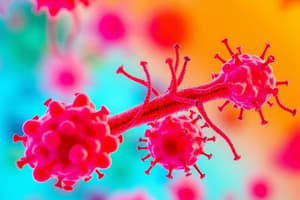Podcast
Questions and Answers
What type of bacteria was used in Italy to rescue art work covered in protective glue?
What type of bacteria was used in Italy to rescue art work covered in protective glue?
- Bacillus subtilis
- Staphylococcus aureus
- Escherichia coli
- Pseudomonas stutzeri (correct)
What traditional chemical reagents further damaged the paintings?
What traditional chemical reagents further damaged the paintings?
- Ethanol
- Pseudomonas stutzeri (correct)
- Acetone
- Hydrogen peroxide
What can Pseudomonas stutzeri degrade?
What can Pseudomonas stutzeri degrade?
- Cellulose and hemicellulose
- Nitrogens, plastic resins, and tetrachloroethylene (correct)
- Proteins and nucleic acids
- Carbohydrates and lipids
What is the most abundant type of microorganisms on earth?
What is the most abundant type of microorganisms on earth?
Which type of organisms are too small to be seen individually by the naked eye?
Which type of organisms are too small to be seen individually by the naked eye?
What is the primary focus of the passage?
What is the primary focus of the passage?
Which of the following statements is true about Pseudomonas stutzeri based on the passage?
Which of the following statements is true about Pseudomonas stutzeri based on the passage?
What is the significance of the 6 to 12 hour contact time mentioned in the passage?
What is the significance of the 6 to 12 hour contact time mentioned in the passage?
Which type of microorganisms are NOT mentioned in the passage?
Which type of microorganisms are NOT mentioned in the passage?
Based on the passage, what percentage of the earth's living matter do microbes comprise?
Based on the passage, what percentage of the earth's living matter do microbes comprise?
Flashcards are hidden until you start studying




